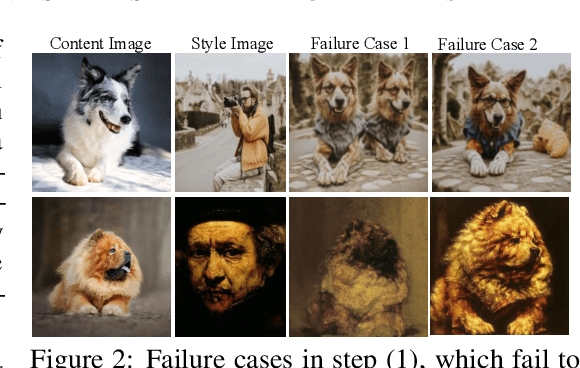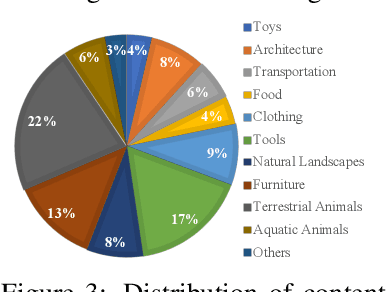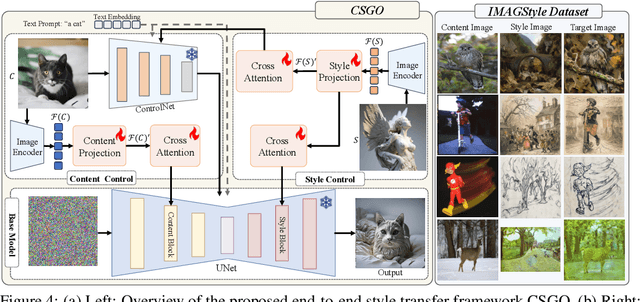Haofan Wang
EasyControl: Adding Efficient and Flexible Control for Diffusion Transformer
Mar 10, 2025Abstract:Recent advancements in Unet-based diffusion models, such as ControlNet and IP-Adapter, have introduced effective spatial and subject control mechanisms. However, the DiT (Diffusion Transformer) architecture still struggles with efficient and flexible control. To tackle this issue, we propose EasyControl, a novel framework designed to unify condition-guided diffusion transformers with high efficiency and flexibility. Our framework is built on three key innovations. First, we introduce a lightweight Condition Injection LoRA Module. This module processes conditional signals in isolation, acting as a plug-and-play solution. It avoids modifying the base model weights, ensuring compatibility with customized models and enabling the flexible injection of diverse conditions. Notably, this module also supports harmonious and robust zero-shot multi-condition generalization, even when trained only on single-condition data. Second, we propose a Position-Aware Training Paradigm. This approach standardizes input conditions to fixed resolutions, allowing the generation of images with arbitrary aspect ratios and flexible resolutions. At the same time, it optimizes computational efficiency, making the framework more practical for real-world applications. Third, we develop a Causal Attention Mechanism combined with the KV Cache technique, adapted for conditional generation tasks. This innovation significantly reduces the latency of image synthesis, improving the overall efficiency of the framework. Through extensive experiments, we demonstrate that EasyControl achieves exceptional performance across various application scenarios. These innovations collectively make our framework highly efficient, flexible, and suitable for a wide range of tasks.
Region-Aware Text-to-Image Generation via Hard Binding and Soft Refinement
Nov 15, 2024Abstract:Regional prompting, or compositional generation, which enables fine-grained spatial control, has gained increasing attention for its practicality in real-world applications. However, previous methods either introduce additional trainable modules, thus only applicable to specific models, or manipulate on score maps within cross-attention layers using attention masks, resulting in limited control strength when the number of regions increases. To handle these limitations, we present RAG, a Regional-Aware text-to-image Generation method conditioned on regional descriptions for precise layout composition. RAG decouple the multi-region generation into two sub-tasks, the construction of individual region (Regional Hard Binding) that ensures the regional prompt is properly executed, and the overall detail refinement (Regional Soft Refinement) over regions that dismiss the visual boundaries and enhance adjacent interactions. Furthermore, RAG novelly makes repainting feasible, where users can modify specific unsatisfied regions in the last generation while keeping all other regions unchanged, without relying on additional inpainting models. Our approach is tuning-free and applicable to other frameworks as an enhancement to the prompt following property. Quantitative and qualitative experiments demonstrate that RAG achieves superior performance over attribute binding and object relationship than previous tuning-free methods.
Training-free Regional Prompting for Diffusion Transformers
Nov 04, 2024Abstract:Diffusion models have demonstrated excellent capabilities in text-to-image generation. Their semantic understanding (i.e., prompt following) ability has also been greatly improved with large language models (e.g., T5, Llama). However, existing models cannot perfectly handle long and complex text prompts, especially when the text prompts contain various objects with numerous attributes and interrelated spatial relationships. While many regional prompting methods have been proposed for UNet-based models (SD1.5, SDXL), but there are still no implementations based on the recent Diffusion Transformer (DiT) architecture, such as SD3 and FLUX.1.In this report, we propose and implement regional prompting for FLUX.1 based on attention manipulation, which enables DiT with fined-grained compositional text-to-image generation capability in a training-free manner. Code is available at https://github.com/antonioo-c/Regional-Prompting-FLUX.
InstantIR: Blind Image Restoration with Instant Generative Reference
Oct 09, 2024



Abstract:Handling test-time unknown degradation is the major challenge in Blind Image Restoration (BIR), necessitating high model generalization. An effective strategy is to incorporate prior knowledge, either from human input or generative model. In this paper, we introduce Instant-reference Image Restoration (InstantIR), a novel diffusion-based BIR method which dynamically adjusts generation condition during inference. We first extract a compact representation of the input via a pre-trained vision encoder. At each generation step, this representation is used to decode current diffusion latent and instantiate it in the generative prior. The degraded image is then encoded with this reference, providing robust generation condition. We observe the variance of generative references fluctuate with degradation intensity, which we further leverage as an indicator for developing a sampling algorithm adaptive to input quality. Extensive experiments demonstrate InstantIR achieves state-of-the-art performance and offering outstanding visual quality. Through modulating generative references with textual description, InstantIR can restore extreme degradation and additionally feature creative restoration.
Image Watermarks are Removable Using Controllable Regeneration from Clean Noise
Oct 07, 2024Abstract:Image watermark techniques provide an effective way to assert ownership, deter misuse, and trace content sources, which has become increasingly essential in the era of large generative models. A critical attribute of watermark techniques is their robustness against various manipulations. In this paper, we introduce a watermark removal approach capable of effectively nullifying the state of the art watermarking techniques. Our primary insight involves regenerating the watermarked image starting from a clean Gaussian noise via a controllable diffusion model, utilizing the extracted semantic and spatial features from the watermarked image. The semantic control adapter and the spatial control network are specifically trained to control the denoising process towards ensuring image quality and enhancing consistency between the cleaned image and the original watermarked image. To achieve a smooth trade-off between watermark removal performance and image consistency, we further propose an adjustable and controllable regeneration scheme. This scheme adds varying numbers of noise steps to the latent representation of the watermarked image, followed by a controlled denoising process starting from this noisy latent representation. As the number of noise steps increases, the latent representation progressively approaches clean Gaussian noise, facilitating the desired trade-off. We apply our watermark removal methods across various watermarking techniques, and the results demonstrate that our methods offer superior visual consistency/quality and enhanced watermark removal performance compared to existing regeneration approaches.
CSGO: Content-Style Composition in Text-to-Image Generation
Sep 04, 2024



Abstract:The diffusion model has shown exceptional capabilities in controlled image generation, which has further fueled interest in image style transfer. Existing works mainly focus on training free-based methods (e.g., image inversion) due to the scarcity of specific data. In this study, we present a data construction pipeline for content-style-stylized image triplets that generates and automatically cleanses stylized data triplets. Based on this pipeline, we construct a dataset IMAGStyle, the first large-scale style transfer dataset containing 210k image triplets, available for the community to explore and research. Equipped with IMAGStyle, we propose CSGO, a style transfer model based on end-to-end training, which explicitly decouples content and style features employing independent feature injection. The unified CSGO implements image-driven style transfer, text-driven stylized synthesis, and text editing-driven stylized synthesis. Extensive experiments demonstrate the effectiveness of our approach in enhancing style control capabilities in image generation. Additional visualization and access to the source code can be located on the project page: \url{https://csgo-gen.github.io/}.
Multi-scale Multi-instance Visual Sound Localization and Segmentation
Aug 31, 2024Abstract:Visual sound localization is a typical and challenging problem that predicts the location of objects corresponding to the sound source in a video. Previous methods mainly used the audio-visual association between global audio and one-scale visual features to localize sounding objects in each image. Despite their promising performance, they omitted multi-scale visual features of the corresponding image, and they cannot learn discriminative regions compared to ground truths. To address this issue, we propose a novel multi-scale multi-instance visual sound localization framework, namely M2VSL, that can directly learn multi-scale semantic features associated with sound sources from the input image to localize sounding objects. Specifically, our M2VSL leverages learnable multi-scale visual features to align audio-visual representations at multi-level locations of the corresponding image. We also introduce a novel multi-scale multi-instance transformer to dynamically aggregate multi-scale cross-modal representations for visual sound localization. We conduct extensive experiments on VGGSound-Instruments, VGG-Sound Sources, and AVSBench benchmarks. The results demonstrate that the proposed M2VSL can achieve state-of-the-art performance on sounding object localization and segmentation.
InstantStyle-Plus: Style Transfer with Content-Preserving in Text-to-Image Generation
Jun 30, 2024



Abstract:Style transfer is an inventive process designed to create an image that maintains the essence of the original while embracing the visual style of another. Although diffusion models have demonstrated impressive generative power in personalized subject-driven or style-driven applications, existing state-of-the-art methods still encounter difficulties in achieving a seamless balance between content preservation and style enhancement. For example, amplifying the style's influence can often undermine the structural integrity of the content. To address these challenges, we deconstruct the style transfer task into three core elements: 1) Style, focusing on the image's aesthetic characteristics; 2) Spatial Structure, concerning the geometric arrangement and composition of visual elements; and 3) Semantic Content, which captures the conceptual meaning of the image. Guided by these principles, we introduce InstantStyle-Plus, an approach that prioritizes the integrity of the original content while seamlessly integrating the target style. Specifically, our method accomplishes style injection through an efficient, lightweight process, utilizing the cutting-edge InstantStyle framework. To reinforce the content preservation, we initiate the process with an inverted content latent noise and a versatile plug-and-play tile ControlNet for preserving the original image's intrinsic layout. We also incorporate a global semantic adapter to enhance the semantic content's fidelity. To safeguard against the dilution of style information, a style extractor is employed as discriminator for providing supplementary style guidance. Codes will be available at https://github.com/instantX-research/InstantStyle-Plus.
Unified Video-Language Pre-training with Synchronized Audio
May 12, 2024Abstract:Video-language pre-training is a typical and challenging problem that aims at learning visual and textual representations from large-scale data in a self-supervised way. Existing pre-training approaches either captured the correspondence of image-text pairs or utilized temporal ordering of frames. However, they do not explicitly explore the natural synchronization between audio and the other two modalities. In this work, we propose an enhanced framework for Video-Language pre-training with Synchronized Audio, termed as VLSA, that can learn tri-modal representations in a unified self-supervised transformer. Specifically, our VLSA jointly aggregates embeddings of local patches and global tokens for video, text, and audio. Furthermore, we utilize local-patch masked modeling to learn modality-aware features, and leverage global audio matching to capture audio-guided features for video and text. We conduct extensive experiments on retrieval across text, video, and audio. Our simple model pre-trained on only 0.9M data achieves improving results against state-of-the-art baselines. In addition, qualitative visualizations vividly showcase the superiority of our VLSA in learning discriminative visual-textual representations.
Multimodal Sense-Informed Prediction of 3D Human Motions
May 05, 2024



Abstract:Predicting future human pose is a fundamental application for machine intelligence, which drives robots to plan their behavior and paths ahead of time to seamlessly accomplish human-robot collaboration in real-world 3D scenarios. Despite encouraging results, existing approaches rarely consider the effects of the external scene on the motion sequence, leading to pronounced artifacts and physical implausibilities in the predictions. To address this limitation, this work introduces a novel multi-modal sense-informed motion prediction approach, which conditions high-fidelity generation on two modal information: external 3D scene, and internal human gaze, and is able to recognize their salience for future human activity. Furthermore, the gaze information is regarded as the human intention, and combined with both motion and scene features, we construct a ternary intention-aware attention to supervise the generation to match where the human wants to reach. Meanwhile, we introduce semantic coherence-aware attention to explicitly distinguish the salient point clouds and the underlying ones, to ensure a reasonable interaction of the generated sequence with the 3D scene. On two real-world benchmarks, the proposed method achieves state-of-the-art performance both in 3D human pose and trajectory prediction.
 Add to Chrome
Add to Chrome Add to Firefox
Add to Firefox Add to Edge
Add to Edge